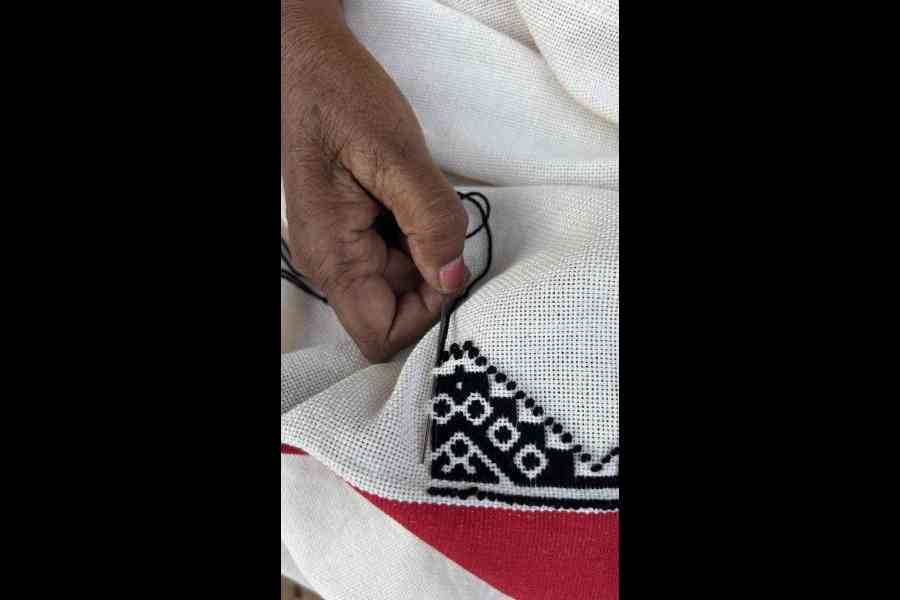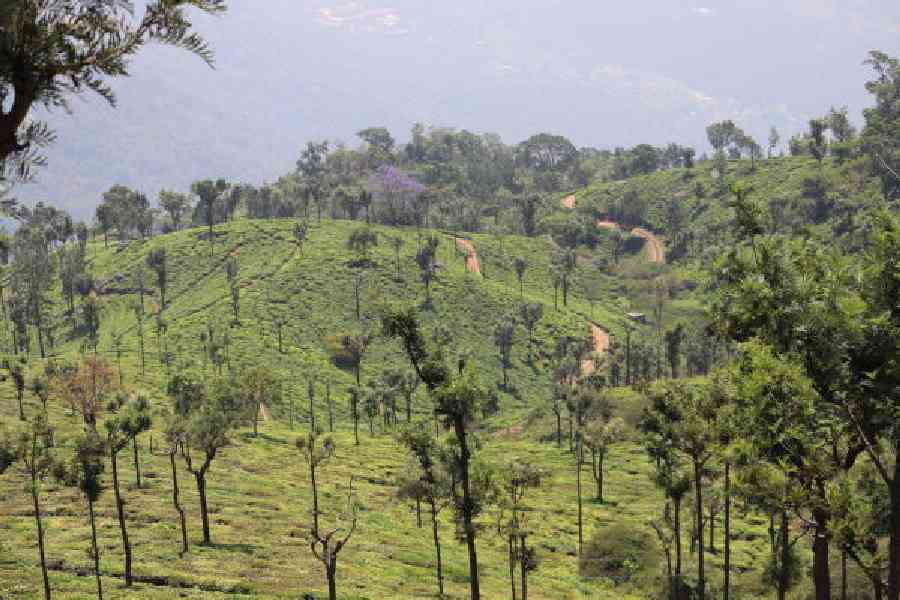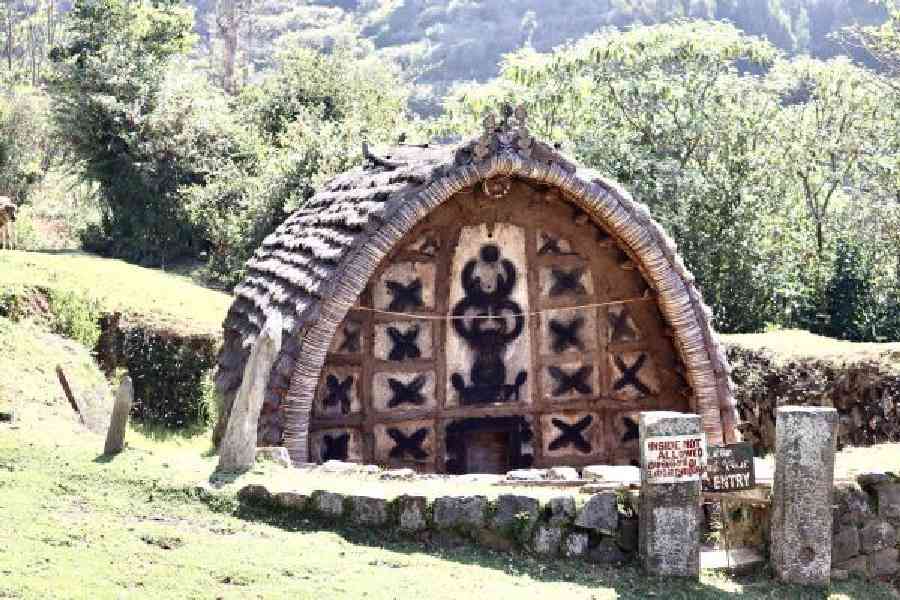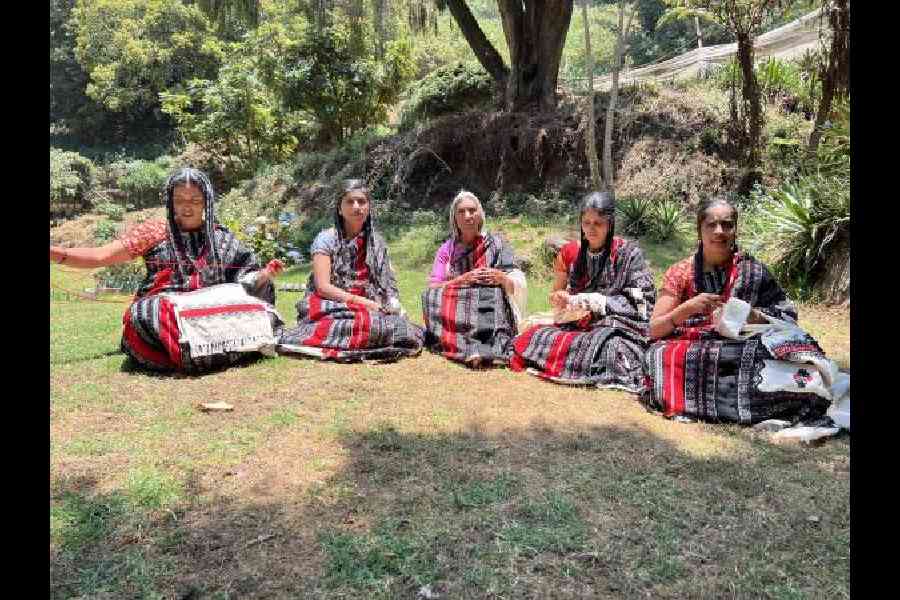A soft chill engulfed me as my SUV made its way up from the hot plains of Coimbatore to the cosy town of Ooty, nestled in the bed of nature in the Nilgiris district of Tamil Nadu. A quick lunch, nine hairpin bends and four hours of careful driving later, we reached Sinclairs Retreat in Ooty. We were looking forward to learn about the work of the Toda artisans seen on shawls in the portfolio of lifestyle brand Jaypore, a unit of Aditya Birla Fashion & Retail. The next day, after a 30-minute and a one-hour drive respectively, I reached two Toda villages in Glenmorgan and Botanical Garden.

Close-up of Toda embroidery
With a population of around 1,600, spread in approximately 70 settlements, the guardians of the Nilgiris, the Todas are one of the few indigenous tribes that continue to inhabit Udhagamandalam, famously known as Ooty. The now endangered tribe was the first occupant of Nilgiris and has a distinctive way of living. As history narrates, the British had to buy acres of land from the Todas when they wanted to convert the then Ootacamund into a place to rewind for officials posted in the heat of Tamil Nadu, Chennai and surrounding places. To understand the role Ooty played in the British period in the South, a good correlation would be what Darjeeling was to them in the East.
PUKHOOR — AN ENDANGERED FORM OF EMBROIDERY
Pukhoor, meaning flower in the Toda language, is the local name for their nature-inspired embroidery. For centuries, the Toda women have taken up embroidery as their favourite pastime. There are only 400 to 500 women who continue to keep their unique form of embroidery alive. The puthkulis they embroider are imperative clothing pieces that must be worn by people from the tribe on special occasions and during religious ceremonies. The puthkulis are double-layered shawls worn by men and women.

All the Toda villages are located in the lap of nature, miles away from the bustling city noises of the hot tourist spot - Nilgiri Hills
Their intricate work on handwoven and unbleached white and off-white pieces of cloth appears to be like a woven cloth with a fine finish using red, black and the sporadic use of blue threads. While white (perth kurh) depicts innocence, red (podha kurh) depicts adolescence and black (kar kurh) stands for maturity. Notably, the artisans need to keep a count through which their planned design is achieved. If the count is lost in a single place, the entire embroidery has to be restarted. Women of the tribe do not share the methods or way of pukhoor with outsiders as they fear inauthentic commercialisation.
When we met Sai Lakshmi Sin at Manjakal mund, she said: “We don’t plan before beginning the embroidery. It is like how the hand flows... and you should not forget count. We embroider plants, sky, flowers and other designs inspired by nature. I learnt it from my grandmother, and she learnt from hers. Each shawl that we make for Jaypore takes a month to make and puthkulis take much longer. It is a hobby, something our women have done forever. I want to teach my granddaughter too.” Nirupa Sin, Sai Lakshmi’s daughter-in-law, showed us the method of embroidery in detail.
She told us that the newer generation makes diamonds and hearts, too, as a part of the designs. Nirupa made Manjakal mund unforgettable as she embroidered S with a small heart on the Jaypore shawl I was wearing.
CULTURE AND TRADITIONS
The Todas mostly live on high altitudes where the utility of an electric fan is scarce. On my visit to the Tarnadu mund and Manjakal mund, the sheer balance between their contagious energy and calming demeanour was a sight to behold. The Toda language is a spoken one and if it had to be written, the Tamil script would be used. Munds are settlements in the local language and the Todas treat their houses as temples. In fact, their houses have very low entrances which they see as an effort to stay grounded and humble. Agriculture continues to play a huge role in their income sources. However, in Manjakal mund, on meeting Narthey Kuttan, who has played under-15 and under-19 football at the national level, the increasing interest of the younger generation was evident. Interestingly, the Toda children tend to return to their villages and maintain peaceful bonds in joint families.

The Toda temple
I was lucky enough to get a typical Toda lunch with rice, homemade butter, a delicious chutney, sautéed carrots and milk rice. Milk rice is a flavour that will remain on my palate forever. It has pretty much the same ingredients we would use in kheer or porridge but instead of sugar they use white and brown jaggery with a generous amount of homemade butter. The idea of mixing butter in kheer would have never occurred to me if not for my trip to the land of Todas.
The simple people have worshipped the five elements of nature for centuries and they refer to air, water, sky, fire and earth as the Pandavas. Their bubalus bubalis (water buffaloes) are worshipped and the milk is offered inside the temples before using at home. Their temples have a unique wall with motifs of the five elements and a water buffalo’s head on the entrance. Notably, women are not allowed to enter the temple premises and men must wear puthkulis while offering their prayers. Narthey Kuttan told us that the temple has simple open space inside since they do not believe in idol worship.
Another interesting aspect about the Toda culture is their views on marriage. The couple gets engaged and married on the third and seventh months of pregnancy. Before the men can get married, they have to lift some extremely heavy rocks usually placed in front of temples to prove their capabilities as family men. Children walk to school and have miles of safe land to play and run around. Food is uncomplicated and healthy so there is a lot of time to relax.
Women have their own songs and dance forms for occasions and enjoyment. They also performed one such song for us which went like this: Konme ni se/ Nime re wi/ O mire ni/ Sonme isu/ Sonme newi sa/ O Nila Nila Nila Maleh/ Nila NilaIt translates into, I don’t know what will happen in my life in the upcoming years and neither do you. Only God decides the path of our lives. So, we have to live in the present and enjoy life happily. We have gathered here in the moonlight to sing our songs.
You can buy a shawl with Toda or pukhoor work on it at jaypore.com











